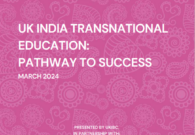Effective responses to Indian opportunities
Every company should be looking at India, but with a very long horizon, says Alasdair Spink Managing Director of Odgers Berndtson

The success of Prime Minister Modi’s visit to London has brought the Indian market literally to our front door. The rally at Wembley where he ‘met’ 60,000 members of the Indian diaspora made him appear like a global pop star, and this image has reinforced the general opinion that India is ripe for investment under this new dynamic leader.
Alasdair Spink, MD of Odgers Berndtson, has seen a sea change since his arrival in India in 2011. His company focuses their executive search on multinationals, and he is head of their industrial market sector in India. As such, he is in tune with the new wave sweeping across the country and is positive about the impact for British SMEs that are looking to invest.
“India is not yet firing but it will start when it takes its place in the global supply chain like China,” he says. “It has the massive population that would suggest there is a large captive consumer demand with a relatively low cost of labour. This means in the global supply chain it has a significant role to play if it can get itself organised with aspects such as infrastructure. The opportunity is there and, although it’s not coming about as quickly as was the case in China, it will happen over time.
“India is growing faster than China’s correcting economy and in terms of business growth there are pockets of incredible growth which are causing immense excitement such as the automotive sector. The Indian government reworked their calculation for GDP growth and although current estimates place growth at 7.5%, it’s probably nearer to 5.7% by the old calculation. Consumer spending is driving the economy and so the government has given the public sector a pay rise.
“Additionally the phenomenon of major companies positioning their back offices in India continues to intensify. We’re currently doing some work with one of the US’ largest investments banks that has a campus in Bangalore and on that campus they will employ more people than they do in the UK and the US. Most of the major multinationals in financial services, retail, and communications have their back offices in India which they continue to grow. Engineering, automotive and aerospace companies that are high engineering are now basing their R&D and engineering back offices in India as well. These are significant opportunity areas and this is where we’re seeing a lot of employment.”
SME opportunities
For SMEs looking to enter the market, preparation is the key according to Alasdair. “I have spent five years creating networks here and getting to know the market and I always try and inject a fair amount of caution to people. I’ve seen so many companies come here, ‘bet against the house’, lose and then leave. We should be more circumspect when advising companies because only then will they take a more cautious route and the amount of companies failing and then leaving will reduce.”
There are pockets of success among the major companies, such as Costa coffee, Twinings and Marks & Spencer. Multi brand retailers such as Tescos and Waitrose cannot have a majority stake in India, with 49% the largest possible stake level. This is why so few enter the market, but this leaves a gap for single brand companies or for smaller independents.
“Do your due diligence and look at the competition very carefully,” says Alasdair. “Don’t assume the Indian competition isn’t good because it is. They can probably beat you on price and they will know the market better than you. Come into the market with a very long horizon and make sure when you hire your contribution that you do not compromise Don’t say ‘this is India and their communication might be less good and they haven’t worked for multinational companies.’ If you don’t get the leadership right, then you will never win. These people must be cast iron. Work harder to recruit your leadership than in any other part of your business.”
Current challenges
In the World Bank’s Ease of Doing Business, India has slipped in the last decade, currently 142 out of 189. Much of this is down to cultural and bureaucratic factors, according to Alasdair. “Overwhelmingly people believe Mr Modi is the right man for the job and he is the best leader India has had for decades. But through no fault of his own he has been blocked from passing meaningful legislation that will help India move forward.
“Generally, foreign businesses hoping to operate within India require three broad legislative changes before they can meaningfully engage with the market. These include land acquisition legislation to ensure land needed for manufacturing will not be taken from businesses, correct labour legislation to abate fears that businesses will never be able to downsize where necessary alongside the implementation of a single tax system among the 29 states that make up the country.”
Alasdair remains hopeful but cautious. “Almost all companies should end up in India but they need to perform very careful and intricate due diligence procedures to establish whether this is the right time to engage with the country.” In simpler terms, an objective assessment of tangible opportunity and risk is absolutely critical to ensuring initial and continued success within the Indian market.









